Unveiling Ancestral Sustainability: A Comprehensive Study of Economic, Environmental, and Social Factors in Potato and Quinoa Cultivation in the Highland Aynokas of Puno, Peru
Abstract
1. Introduction
2. Materials and Methods
2.1. Study Site
2.2. Population and Sample
2.3. Variables Assessed
2.4. Sustainability Indicators
2.4.1. Value of Economic Indicator
2.4.2. Value of Environmental Indicator
2.4.3. Value of Social Indicator
2.5. General Sustainability Index (GSI)
2.6. Selection, Evaluation of Indicators for Sustainable Development, and Validation Process
2.7. Validation of Consistency of Indicators
3. Results
3.1. Sustainability Assessment
3.2. Sustainability of Economic Indicator
3.3. Sustainability of Environmental Indicators
3.4. Sustainability of Social Indicators
3.5. Sustainability of the Ancestral Amoeba Diagram Indicators
3.6. General Sustainability Index (GSI)
4. Discussion
4.1. Preservation and Sustainability of Potato and Quinoa
4.2. Sustainability Economic, Environmental, and Social Indicators
5. Conclusions
Author Contributions
Funding
Institutional Review Board Statement
Informed Consent Statement
Data Availability Statement
Acknowledgments
Conflicts of Interest
References
- Damonte, G. Construyendo Territorios: Narrativas Territoriales Aymaras Contemporáneas. 2011. Available online: https://www.grade.org.pe/upload/publicaciones/archivo/download/pubs/LIBROGRADE_CONSTRUYENDOTERRITORIOS.pdf (accessed on 16 May 2023).
- Chumacero Moscoso, C.; Camacho Marquez, M.C. Evolución Del Sistema de Aynuqa Durante Una Década En Cuatro Comunidades Del Altiplano Boliviano. Ecol. Boliv. 2006, 41, 19–39. [Google Scholar]
- INIA Fiestas y Rituales En La Conservación de La Agrobiodiversidad En El Perú. 2007. Available online: http://repositorio.inia.gob.pe/bitstream/20.500.12955/102/3/INIA-Fiestas_rituales_en_la_conservaci%C3%B3n.pdf (accessed on 20 May 2023).
- Chura, F.F.C. Las ainocas en el distrito de Ácora Puno-Perú. Vida Hist. 2019, 3, 48–53. [Google Scholar] [CrossRef]
- Aguilar, P.C.; Jacobsen, S.-E. Cultivation of Quinoa on the Peruvian Altiplano. Food Rev. Int. 2003, 19, 31–41. [Google Scholar] [CrossRef]
- Apaza Ticona, J.; Alanoca Arocutipa, V.; Ticona Alacona, C.; Calderon Torres, A.; Maquera Maquera, Y. Educación y Alimentación En Las Comunidades Aymaras de Puno. Comuni@Cción Rev. Investig. Comun. Desarro. 2019, 10, 36–46. [Google Scholar] [CrossRef]
- Velazques, S. Tradición y Modernidad en el Sistema de Aynuqas en Las Comunidades Aymaras de Juli—Perú; Universidad de Chile: Santiago, Chile, 2005. [Google Scholar]
- Kuczuk, A.; Widera, K. A Greater Share of Organic Agriculture in Relation to Food Security Resulting from the Energy Demand Obtained from Food—Scenarios for Poland until 2030. Energies 2021, 14, 6959. [Google Scholar] [CrossRef]
- Rodas Arano, C.V. El Cercado de La Llama Libre: Transformaciones En El Territorio Comunitario de Curahuara de Carangas (Prov. Sajama, Dpto. Oruro, Bolivia 2007–2013). Bull. Inst. Français Études Andin. 2014, 355–367. [Google Scholar] [CrossRef][Green Version]
- Casilla, G.R.; Paz, L. El Sistema de Aynuqa: Memoria e Historia de La Comunidad (Comunidades Aymaras Del Altiplano Boliviano). Dinámicas Descanso Tierra Andes 1994. Available online: https://www.researchgate.net/publication/32974377_El_sistema_de_aynuqa_memoria_e_historia_de_la_comunidad_comunidades_aymara_del_Altiplano_Boliviano (accessed on 30 June 2023).
- Ormachea, E.; Nilton Ramirez, S. Propiedad Colectiva de la Tierra y Producción Agrícola Capitalista el Caso de la Quinua en el Altiplano sur de Bolivia; Consejo Latinoamericano de Ciencias Sociales: Buenos Aires, Argentina, 2013. [Google Scholar]
- Walshe, R.; Argumedo, A. Ayni, Ayllu, Yanantin and Chanincha: The Cultural Values Enabling Adaptation to Climate Change in Communities of the Potato Park, in the Peruvian Andes. GAIA—Ecol. Perspect. Sci. Soc. 2016, 25, 166–173. [Google Scholar] [CrossRef]
- Devaux, A.; Kromann, P.; Ortiz, O. Potatoes for Sustainable Global Food Security. Potato Res. 2014, 57, 185–199. [Google Scholar] [CrossRef]
- Singh, J. Advances in Potato Chemistry and Technology. 2009. Available online: https://www.sciencedirect.com/book/9780123743497/advances-in-potato-chemistry-and-technology (accessed on 15 July 2023).
- Van Kessel, J.; Larraín Barros, H. Manos Sabias para Criar la Vida: Tecnología Andina: Simposio del 49o Congreso Internacional de Americanistas (Quito, Julio de 1997); Ediciones Abya-Yala: Quito, Ecuador, 2000; ISBN 9978046194. [Google Scholar]
- Nieto-Cabrera, C.; Francis, C.; Caicedo, C.; Gutierrez, P.F.; Rivera, M. Response of Four Andean Crops to Rotation and Fertilization. Mt. Res. Dev. 1997, 17, 273. [Google Scholar] [CrossRef]
- Zimmerer, K.S.; De Haan, S. Informal Food Chains and Agrobiodiversity Need Strengthening-Not Weakening-to Address Food Security amidst the COVID-19 Crisis in South America. Food Sec. 2020, 12, 891–894. [Google Scholar] [CrossRef]
- Dostalíková, L.; Hlásná Čepková, P.; Janovská, D.; Svoboda, P.; Jágr, M.; Dvořáček, V.; Viehmannová, I. Nutritional Evaluation of Quinoa Genetic Resources Growing in the Climatic Conditions of Central Europe. Foods 2023, 12, 71440. [Google Scholar] [CrossRef]
- Food and Agriculture Organization of the United Nations (FAO). Climate Change and Food Security: Risks and Responses; FAO: Rome, Italy, 2015; ISBN 978-92-5-108998-9. [Google Scholar]
- García-Parra, M.; Roa-Acosta, D.; García-Londoño, V.; Moreno-Medina, B.; Bravo-Gomez, J. Structural Characterization and Antioxidant Capacity of Quinoa Cultivars Using Techniques of Ft-Mir and Uhplc/Esi-Orbitrap Ms Spectroscopy. Plants 2021, 10, 2159. [Google Scholar] [CrossRef]
- De Bock, P.; Van Bockstaele, F.; Muylle, H.; Quataert, P.; Vermeir, P.; Eeckhout, M.; Cnops, G. Yield and Nutritional Characterization of Thirteen Quinoa (Chenopodium Quinoa Willd) Varieties Grown in North-west Europe—Part I. Plants 2021, 10, 2689. [Google Scholar] [CrossRef]
- Hayati, D.; Ranjbar, Z.; Karami, E. Measuring Agricultural Sustainability. In Biodiversity, Biofuels, Agroforestry and Conservation Agriculture; Lichtfouse, E., Ed.; Springer: Dordrecht, The Netherlands, 2010; pp. 73–100. [Google Scholar]
- Arulnathan, V.; Heidari, M.D.; Doyon, M.; Li, E.P.H.; Pelletier, N. Economic Indicators for Life Cycle Sustainability Assessment: Going beyond Life Cycle Costing. Sustainability 2023, 15, 13. [Google Scholar] [CrossRef]
- Spânu, I.A.; Ozunu, A.; Petrescu, D.C.; Petrescu-Mag, R.M. A Comparative View of Agri-Environmental Indicators and Stakeholders’ Assessment of Their Quality. Agriculture 2022, 12, 490. [Google Scholar] [CrossRef]
- Mills, J.; Chiswell, H.; Gaskell, P.; Courtney, P.; Brockett, B.; Cusworth, G.; Lobley, M. Developing Farm-Level Social Indicators for Agri-Environment Schemes: A Focus on the Agents of Change. Sustainability 2021, 13, 7820. [Google Scholar] [CrossRef]
- Portugal, J. La Introducción de la Tecnología Moderna en las Relaciones Culturales de la Producción Agrícola del Sistema de las Aynuqas de la Comunidad Causaya—Municipio de Tiwanaku; Universidad Mayor de San Andres: La Paz, Bolivia, 2016. [Google Scholar]
- Schliep, R.; Walz, U.; Sukopp, U.; Heiland, S. Indicators on the Impacts of Climate Change on Biodiversity in Germany—Data Driven or Meeting Political Needs? Sustainability 2018, 10, 3959. [Google Scholar] [CrossRef]
- Pretty, J. Agricultural Sustainability: Concepts, Principles and Evidence. Philos. Trans. R. Soc. B Biol. Sci. 2008, 363, 447–465. [Google Scholar] [CrossRef] [PubMed]
- Barinaga-Rementeria, I.; Etxano, I. Weak or Strong Sustainability in Rural Land Use Planning? Assessing Two Case Studies through Multi-Criteria Analysis. Sustainability 2020, 12, 2422. [Google Scholar] [CrossRef]
- Canaza, D.; Calizaya, E.; Chambi, W.; Calizaya, F.; Mindani, C.; Cuentas, O.; Caira, C.; Huacani, W. Spatial Distribution of Soil Organic Carbon in Relation to Land Use, Based on the Weighted Overlay Technique in the High Andean Ecosystem of Puno—Peru. Sustainability 2023, 15, 10316. [Google Scholar] [CrossRef]
- Martinez, C. Estadística y Muestreo, 13th ed.; de Colombia, B.N., Ed.; ECOE-Ediciones: Bogotá, Colombia, 2012; Available online: https://www.academia.edu/39626329/Estad%C3%ADstica_y_muestreo_Ciro_Mart%C3%ADnez_Bencardino_13ED (accessed on 30 June 2023).
- Scheaffer, R.; Mendenhall, W.; Ott, R.L. Elementos de Muestreo (Traducido), 6th ed.; Grupo Editorial Iberoamerica, S.A.: Madrid, Spain, 2007; Available online: https://issuu.com/hectorm.delossantos-posadas/docs/elementos_de_muestreo_-_schaffer_et (accessed on 30 June 2023).
- Márquez, F.R.; Julca, A.M. Indicadores Para Evaluar La Sustentabilidad En Fincas Cafetaleras En Quillabamba Cusco. Perú. Saber Hacer 2015, 2, 128–137. [Google Scholar]
- Sarandon, S.; Flores, C. Evaluación De La Sustentabilidad En Agroecosistemas: Una Propuesta Metodológica. Agroecología 2009, 4, 19–28. [Google Scholar]
- Sarandon, S.; Zuluaga, M.; Cieza, R.; Gomez, C.; Jajetic, L. Evaluación de La Sustentabili-Dad de Sistemas Agrícolas de Fincas En Misiones, Argentina, Mediante El Uso de Indicadores. Agroecologia 2006, 1, 19–28. [Google Scholar]
- Sarandon, S.J. El Desarrollo y Uso de Indicadores Para Evaluar La Sustentabilidad de Los Agroecosistemas. Agroecologia. In Agroecología. El Camino Hacia Una Agricultura Sustentable; Ediciones Científicas Americanas: La Plata, Argentina, 2002; Volume 20, pp. 393–414. Available online: https://wp.ufpel.edu.br/consagro/files/2010/10/SARANDON-cap-20-Sustentabilidad.pdf (accessed on 1 July 2023).
- Smyth, A.; Dumanski, J. A Framework for Evaluating Sustainable Land Management. Can. J. Soil. Sci. 1995, 75, 401–406. [Google Scholar] [CrossRef]
- Astier, M.; Masera, O.; Galván, Y. Evaluación de Sustentabilidad. In Un Enfoque Dinámico y Multidimensional; IMAG IMPRESSIONS, S.L., Benifaió: Valencia, Spain, 2008; ISBN 978-84-612-5641-9. [Google Scholar]
- Pinedo-Taco, R.; Gómez-Pando, L.; Berens, D.A. Índice de sostenibilidad de producción de quinua orgánica (Chenopodium quinoa Willd.) en valles interandinos del Perú. Trop. Subtrop. Agroecosyst. 2022, 25, 2022. [Google Scholar] [CrossRef]
- Sarandon, S.; Flores, C. Agroecología: Bases Teóricas para el Diseño y Manejo de Agroecosistemas Sustentables; Universidad de la Plata: Buenos Aires, Argentina, 2014. [Google Scholar]
- Iglesias-Gómez, J.M.; Toral-Pérez, O.C.; Rodríguez-Licea, G. Evaluación de La Biodiversidad En Una f Inca En Transición Agroecológica. Rev. Terra Latinoam. 2022, 40, 1–12.e957. [Google Scholar] [CrossRef]
- Geilfus, F. 80 Herramientas para el Desarrollo Participativo, Diagnóstico, Planificación Monitoreo y Evaluación; Octava Edicion: San José, Costa Rica, 2009. [Google Scholar]
- Barrantes, C.; Siura, S.; Castillo, E.; Huarcaya, M.; Rado, J. Guía para el Análisis de la Sostenibilidad de Sistemas de Producción de la Agricultura Familiar (SPAF), 1st ed.; Instituto Interamericano de Cooperación para la Agricultura (IICA): Lima, Perú, 2018. [Google Scholar]
- Valverde-Reyes, N.C.; Pinedo-Taco, R. Indice de sostenibilidad de la producción de camote (Ipomoea Batatas Lam.): Análisis Multivariado. Trop. Subtrop. Agroecosyst. 2022, 25. [Google Scholar] [CrossRef]
- Sarandón, S.J. AGROECOLOGIA: El Camino Hacia Una Agricultura Sustentable; Ediciones Científicas Americanas: La Plata, Argentina, 2002; 560p, ISBN 987-9486-03-X. [Google Scholar]
- Wu, X.; Wang, Y.; Zhu, H. Does Economic Growth Lead to an Increase in Cultivated Land Pressure? Evidence from China. Land 2022, 11, 1515. [Google Scholar] [CrossRef]
- Swarnam, T.P.; Velmurugan, A.; Ravisankar, N.; Singh, A.K.; Zamir Ahmed, S.K. Diversification of Island Agriculture—A Viable Strategy for Adaptation to Climate Change. In Biodiversity and Climate Change Adaptation in Tropical Islands; Academic Press: Cambridge, MA, USA, 2018; pp. 553–575. [Google Scholar] [CrossRef]
- Di Bene, C.; Francaviglia, R.; Farina, R.; Álvaro-Fuentes, J.; Zornoza, R. Agricultural Diversification. Agriculture 2022, 12, 369. [Google Scholar] [CrossRef]
- Pulvento, C.; Bazile, D. Worldwide Evaluations of Quinoa—Biodiversity and Food Security under Climate Change Pressures: Advances and Perspectives. Plants 2023, 12, 868. [Google Scholar] [CrossRef] [PubMed]
- INEI CENSOS NACIONALES 2017: XII de Población, VII de Vivienda y III de Comunidades Indígenas. Available online: https://www.inei.gob.pe/media/MenuRecursivo/publicaciones_digitales/Est/Lib1539/libro.pdf. (accessed on 29 June 2023).
- Gobierno de Mexico. El Reparto de Las Tareas y Responsabilidades Entre Mujeres y Hombres. Available online: https://www.gob.mx/sre/articulos/el-reparto-de-las-tareas-y-responsabilidades-entre-mujeres-y-hombres (accessed on 1 July 2023).
- Centro Internacional de Mejoramiento de Maíz y Trigo (CIMMYT). La Adopción de Tecnologías Agrícolas: Guía para el Diseño de Encuestas; Alma McNab, A., Ed.; CIMMYT: El Batán, México, 1993. [Google Scholar]
- Malagon-Zaldua, E.; Begiristain-Zubillaga, M.; Onederra-Aramendi, A. Measuring the Economic Impact of Farmers’ Markets on Local Economies in the Basque Country. Agriculture 2018, 8, 10. [Google Scholar] [CrossRef]
- Alsos, I.G.; Ehrich, D.; Thuiller, W.; Eidesen, P.B.; Tribsch, A.; Schönswetter, P.; Lagaye, C.; Taberlet, P.; Brochmann, C. Genetic Consequences of Climate Change for Northern Plants. Proc. R. Soc. B Boil. Sci. 2012, 279, 2042–2051. [Google Scholar] [CrossRef]
- Pinedo Taco, R.; Gómez Pando, L.; Julca Otiniano, A. Caracterización de Los Sistemas de Producción de Quinua (Chenopodium Quinoa Wiilld) En El Distrito de Chiara, Ayacucho. Aporte St. 2017, 10, 351. [Google Scholar] [CrossRef]
- Arcagni, A.; Fattore, M.; Maggino, F.; Vittadini, G. Some Critical Reflections on the Measurement of Social Sustainability and Well-Being in Complex Societies. Sustainability 2021, 13, 12679. [Google Scholar] [CrossRef]
- Bedoya-Perales, N.S.; Pumi, G.; Mujica, A.; Talamini, E.; Padula, A.D. Quinoa Expansion in Peru and Its Implications for Land Use Management. Sustainability 2018, 10, 532. [Google Scholar] [CrossRef]
- Quispe Mamani, J.C.; Apaza Mamani, E.; Marca Flores, O.H.; Calcina Álvarez, D.A.; Pumacallahui Salcedo, E.; Yapuchura Saico, C.R. Factores Climático Determinantes Del Rendimiento y La Producción de Papa En El Distrito de Juli, Puno–Perú, 2000-2018. Rev. Alfa 2021, 5, 541–554. [Google Scholar] [CrossRef]
- Sustainability Número Especial “Economía de Los Recursos Naturales”. Available online: https://www.mdpi.com/journal/sustainability/special_issues/resources_economics (accessed on 25 April 2023).
- Trigo, A.; Marta-Costa, A.; Fragoso, R. Principles of Sustainable Agriculture: Defining Standardized Reference Points. Sustainability 2021, 13, 4086. [Google Scholar] [CrossRef]
- Bathaei, A.; Štreimikienė, D. A Systematic Review of Agricultural Sustainability Indicators. Agriculture 2023, 13, 241. [Google Scholar] [CrossRef]
- Talukder, B.; Hipel, K.W.; vanLoon, G.W. Developing Composite Indicators for Agricultural Sustainability Assessment: Effect of Normalization and Aggregation Techniques. Resources 2017, 6, 66. [Google Scholar] [CrossRef]
- Koohafkan, P.; Altieri, M.A.; Gimenez, E.H. Green Agriculture: Foundations for Biodiverse, Resilient and Productive Agricultural Systems. Int. J. Agric. Sustain. 2012, 10, 61–75. [Google Scholar] [CrossRef]
- Feil, A.A.; Schreiber, D.; Haetinger, C.; Strasburg, V.J.; Barkert, C.L. Sustainability Indicators for Industrial Organizations: Systematic Review of Literature. Sustainability 2019, 11, 854. [Google Scholar] [CrossRef]
- Taiy, R.J.; Onyango, C.; Nkurumwa, A.; Ngetich, K. Socio-Economic Characteristics of Smallholder Potato Farmers in Mauche Ward of Nakuru County, Kenya. Univers. J. Agric. Res. 2017, 5, 257–266. [Google Scholar] [CrossRef]
- Castoldi, N.; Bechini, L. Integrated Sustainability Assessment of Cropping Systems with Agro-Ecological and Economic Indicators in Northern Italy. Eur. J. Agron. 2010, 32, 59–72. [Google Scholar] [CrossRef]
- Campos, E.; Bravo, R.; Valdivia, R.; Soto, J.L. Vista de PLAGAS INSECTILES SOBRE ÁREASDE INTENSIFICACIÓN DEL CULTIVO DE QUINUA (Chenopodium Quinoa Wild) EN PUNO. Available online: http://revistas.unap.edu.pe/journal/index.php/RCAGRA/article/view/468/405 (accessed on 25 April 2023).
- Tonconi Quispe, J. Producción Agrícola Alimentaria y Cambio Climático: Un Análisis Económico en el Departamento de Puno, Perú. Idesia (Arica) 2015, 33, 119–136. [Google Scholar] [CrossRef]
- Benique Olivera, E. Impacto Económico Del Cambio Climático En Cultivo de Quinua (Chenopodium Quinoa Willd) Orgánica En La Región Del Altiplano: Un Enfoque Ricardiano. Rev. Investig. Altoandinas J. High Andean Res. 2021, 23, 236–243. [Google Scholar] [CrossRef]
- Rogers, S.; Gardner, K.; Carlson, C. Social Capital and Walkability as Social Aspects of Sustainability. Sustainability 2013, 5, 3473–3483. [Google Scholar] [CrossRef]
- Wojewódzka-Wiewiórska, A.; Kłoczko-Gajewska, A.; Sulewski, P. Between the Social and Economic Dimensions of Sustainability in Rural Areas—In Search of Farmers’ Quality of Life. Sustainability 2019, 12, 148. [Google Scholar] [CrossRef]
- Santistevan Méndez, M.; Julca Otiniano, A.; Borjas Ventura, R.; Tuesta Hidalgo, O. Caracterización de Fincas Cafetaleras En La Localidad de Jipijapa (Manabí, Ecuador). Ecol. Appl. 2014, 13, 187–192. [Google Scholar] [CrossRef]
- Nicolosi, A.; Laganà, V.R.; Di Gregorio, D.; Privitera, D. Social Farming in the Virtuous System of the Circular Economy. An Exploratory Research. Sustainability 2021, 13, 989. [Google Scholar] [CrossRef]
- Qin, Y.; Xu, J.; Zhang, H.; Ren, W. The Measurement of the Urban–Rural Integration Level of Resource-Exhausted Cities—A Case Study of Zaozhuang City, China. Sustainability 2022, 15, 418. [Google Scholar] [CrossRef]
- INEI Censo Nacional Agrario Del 2012. Available online: https://proyectos.inei.gob.pe/web/DocumentosPublicos/ResultadosFinalesIVCENAGRO.pdf (accessed on 1 July 2023).
- Thiam, E.; Allaoui, A.; Benlhabib, O. Quinoa Productivity and Stability Evaluation through Varietal and Environmental Interaction. Plants 2021, 10, 714. [Google Scholar] [CrossRef] [PubMed]
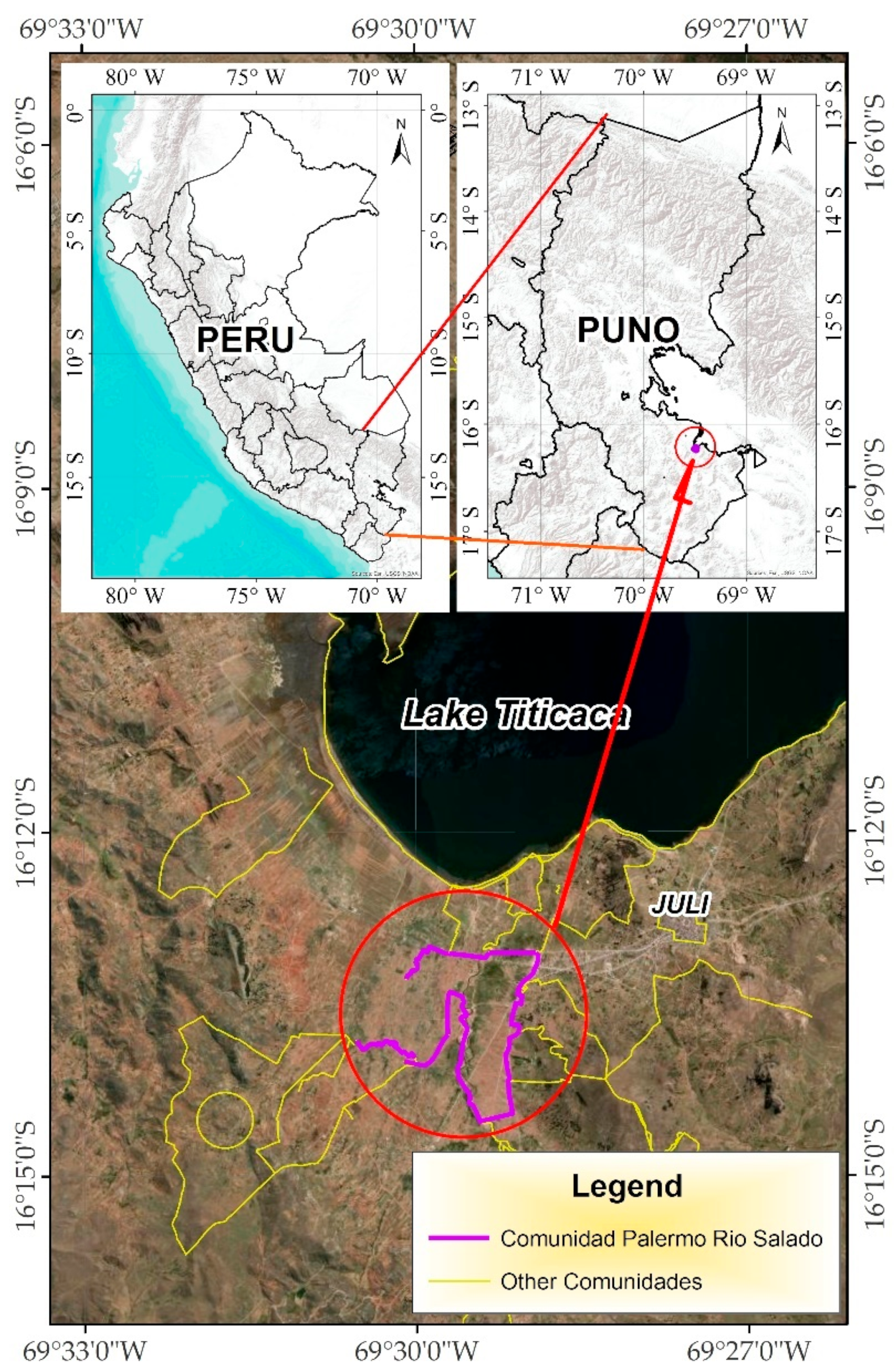
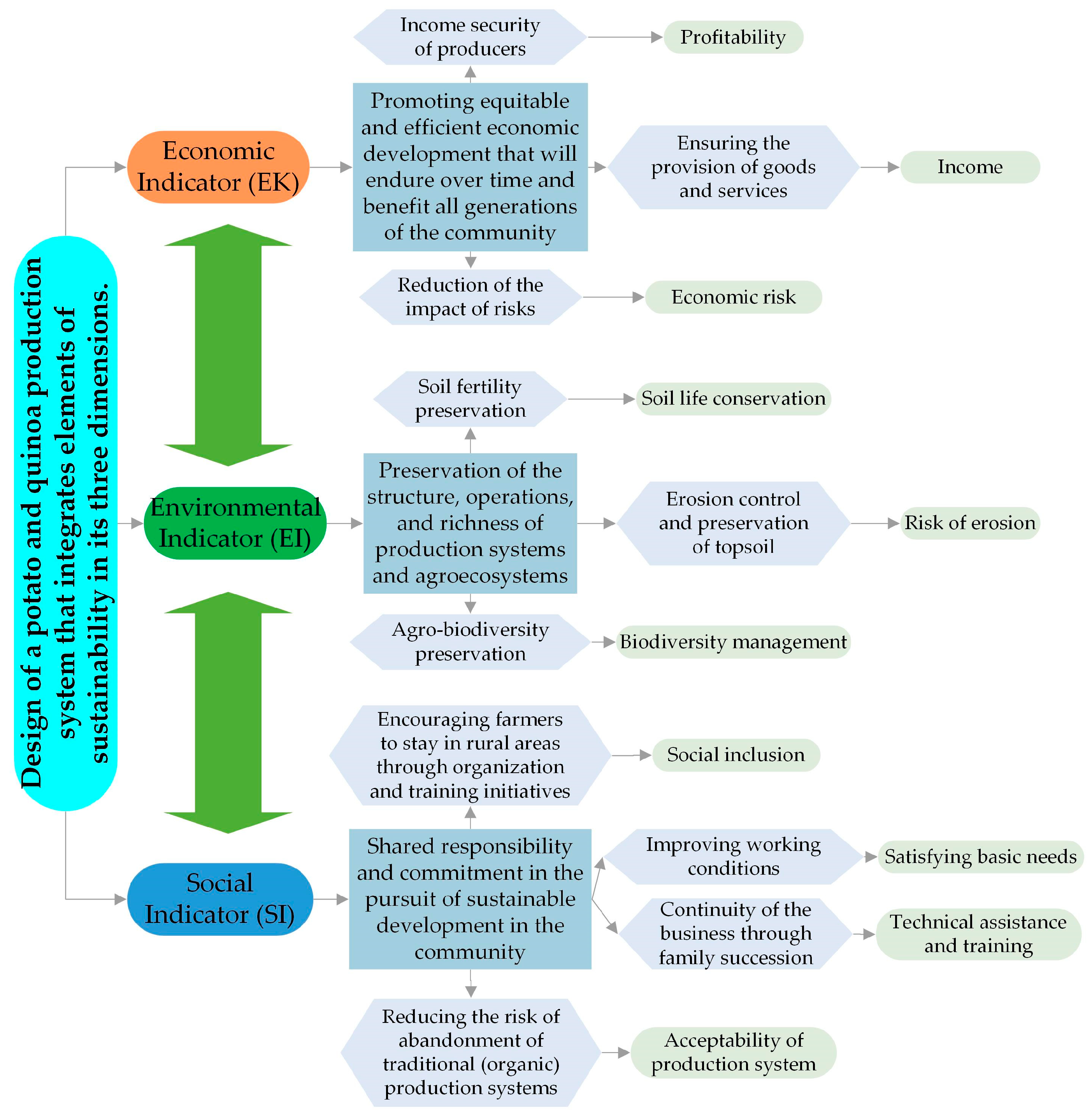
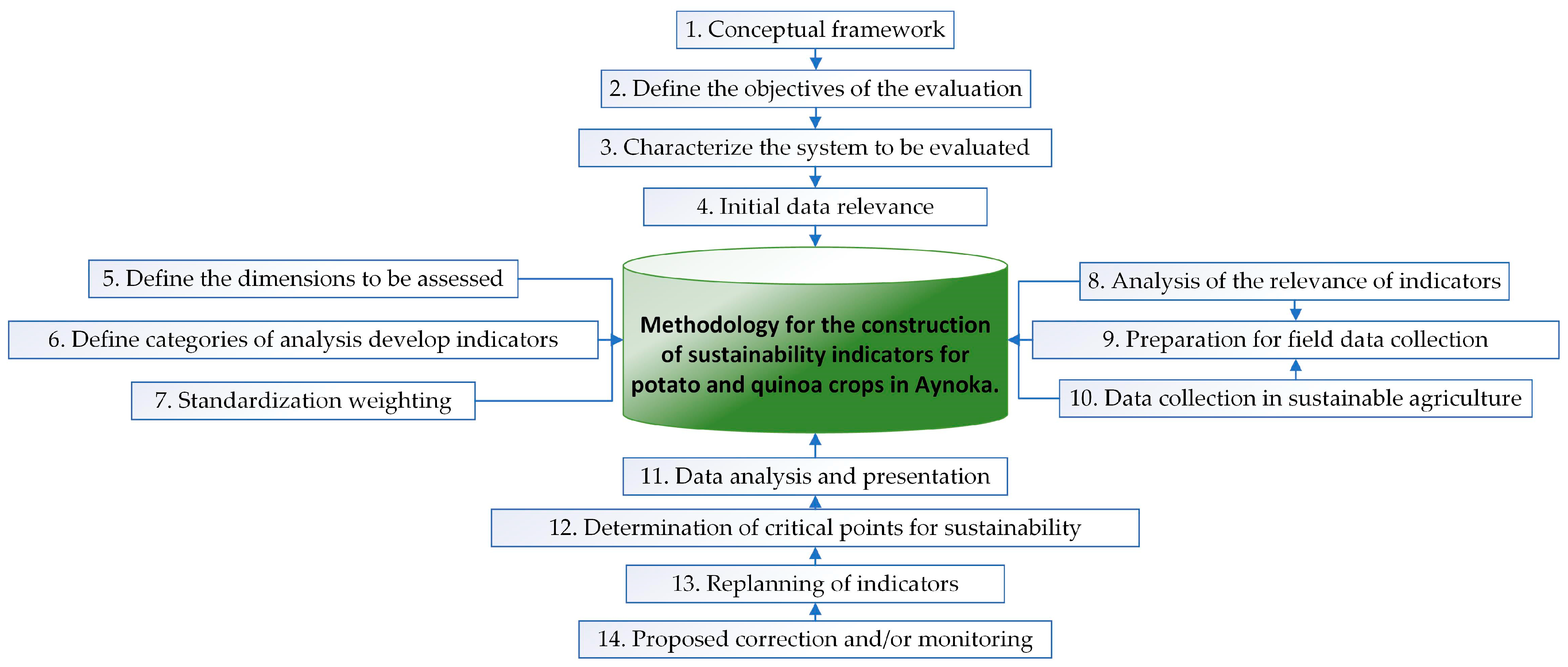
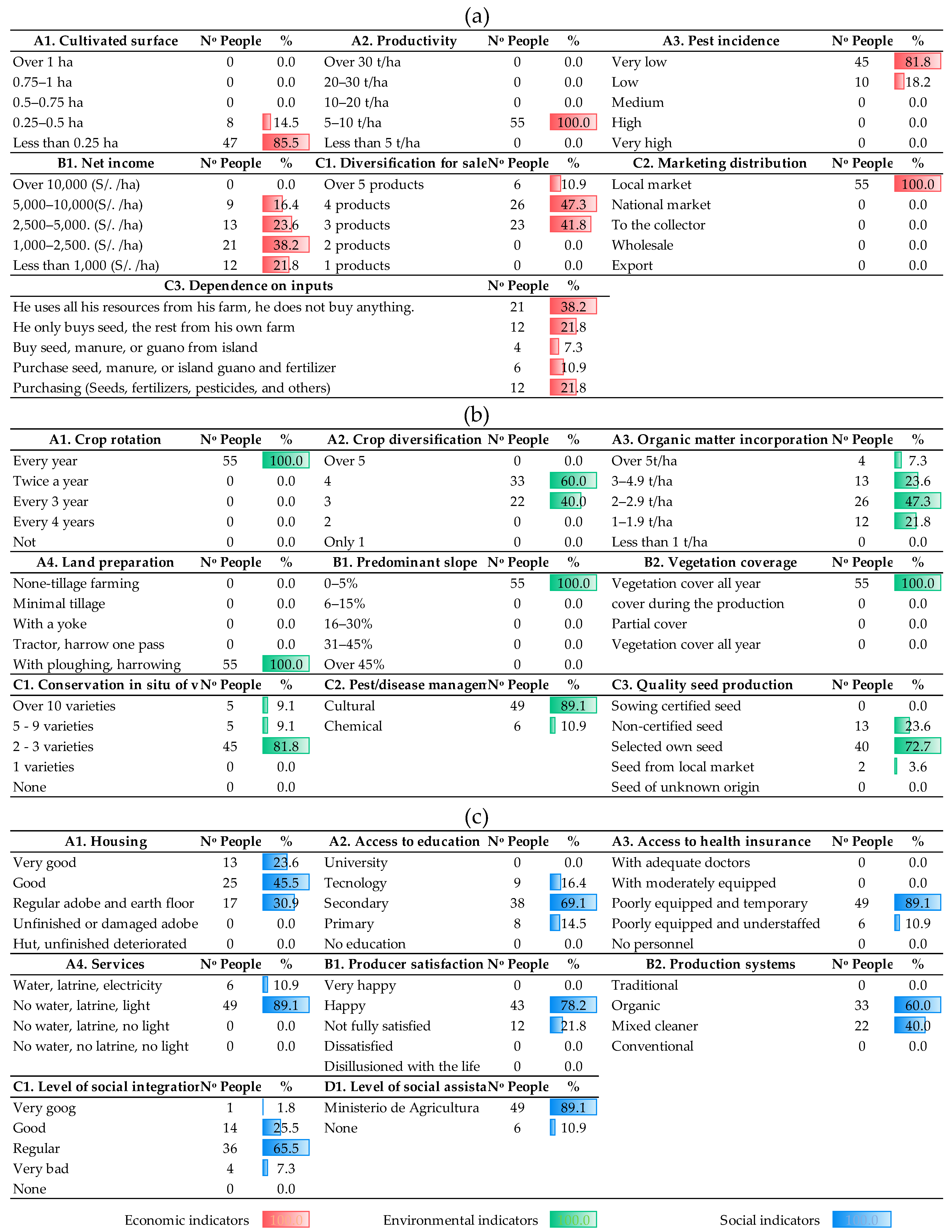
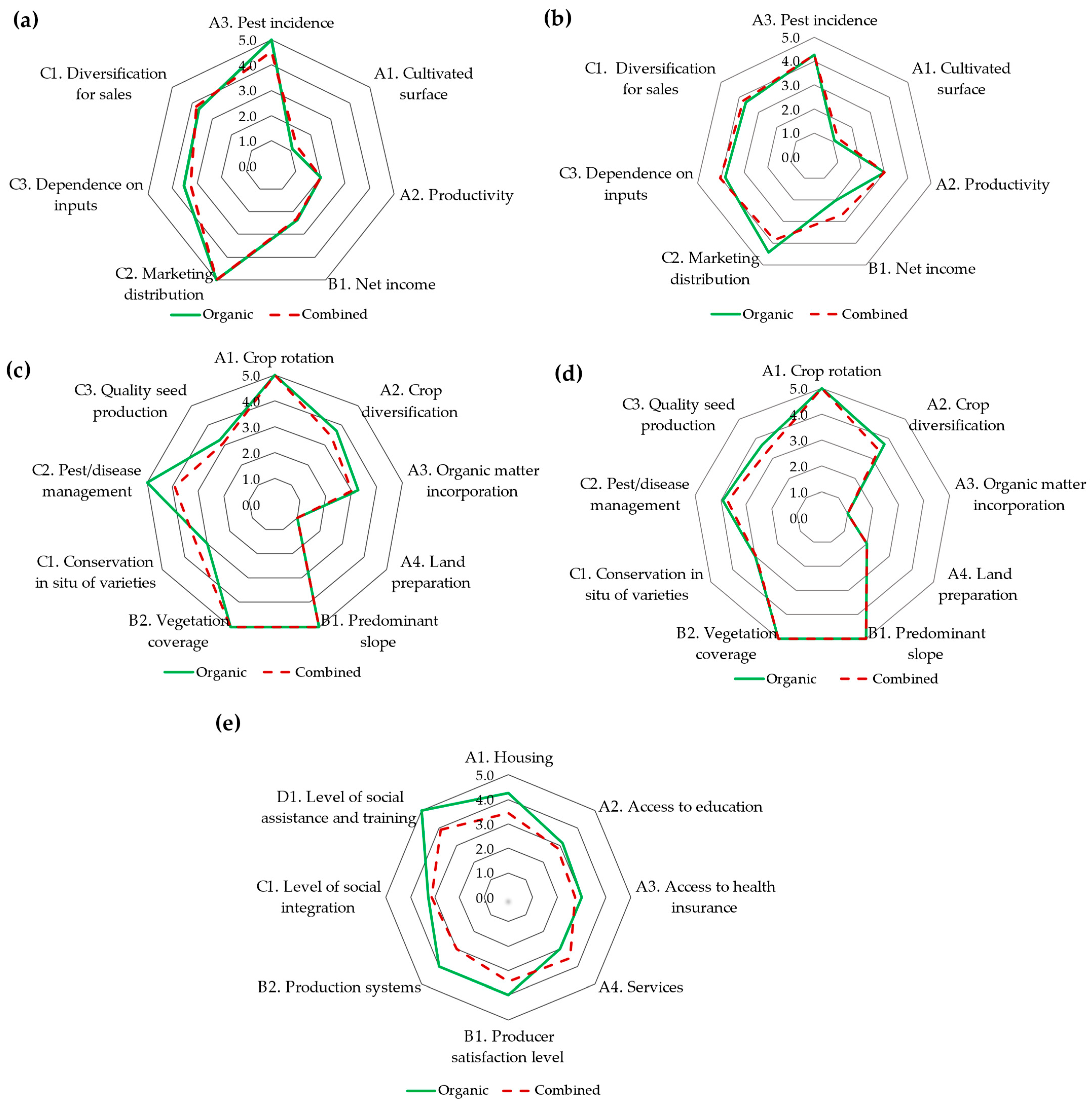
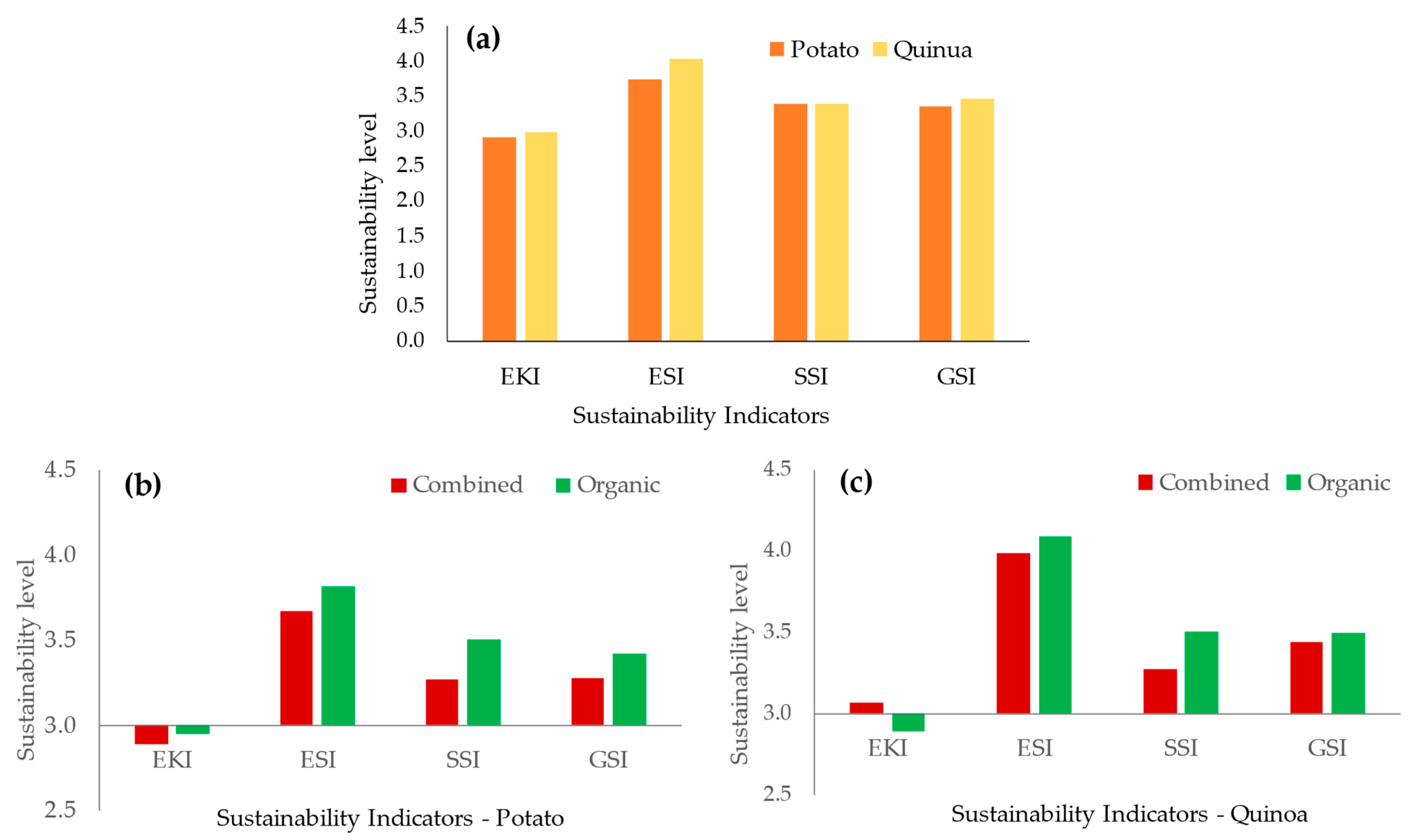
| Economic | Environmental | Social |
|---|---|---|
| A. Profitability | A. Soil life conservation | A. Satisfaction of basic needs |
| A1. Cultivated surface | A1. Crop rotation | A1. Housing type |
| A2. Productivity | A2. Crop diversification | A2. Level of education |
| A3. Pest incidence | A3. Organic matter incorporation | A3. Access to health insurance |
| B. Economic income | A4. Land preparation | A4. Basic services |
| B1. Monthly net income | B. Risk of erosion | B. Acceptability of production systems |
| C. Economic risk | B1. Predominant slope | B1. Producer satisfaction level |
| C1. Diversification for sales | B2. Vegetation coverage | B2. Production systems |
| C2. Marketing distribution | C. managing biodiversity | C1. Level of social integration |
| C3. Dependence on inputs | C1. Conservation in situ of varieties | D. Technical assistance and training |
| - | C2. Pest/disease management | D1. Level of social assistance and training |
| - | C3. Quality seed production | - |
| Scale | Description of Assessment Levels | Sustainability Level |
|---|---|---|
| (1) | The very critical or extreme level of the unsustainability of production systems of | Extreme |
| (2) | low or critical level of sustainability of production systems. The production system requires urgent changes at the level of the components of the three dimensions to reach sustainability values. | Critical |
| (3) | Minimum acceptable threshold of sustainability of quinoa production systems, and the systems need to implement measures to improve their valuation since any adversity in the components of the three dimensions can affect sustainability. | Weak |
| (4) | Medium level of sustainability. Although it is a scale close to the optimal value (5), it is necessary to implement mechanisms for continuous improvement at the economic–technological level, use, and conservation of resources, family, and community. | Well-being |
| (5) | Maximum threshold or high level of sustainability of quinoa production systems to remain at these levels, the production systems need to implement internal quality control mechanisms, efficiency, and effectiveness in using inputs, profitability, and high levels of respect and coexistence in the agroecosystems of the communities of Chiara, Ayacucho. | High |
| A | B | C | Potato | |||||
|---|---|---|---|---|---|---|---|---|
| Economic | A1 | A2 | A3 | B1 | C1 | C2 | C3 | E.K. |
| Combined | 1.27 | 2.00 | 4.55 | 2.32 | 3.77 | 5.00 | 3.27 | 2.89 |
| Organic | 1.06 | 2.00 | 5.00 | 2.36 | 3.64 | 5.00 | 3.55 | 2.95 |
| Average | 1.17 | 2.00 | 4.77 | 2.34 | 3.70 | 5.00 | 3.41 | 2.92 |
| A | B | C | Quinoa | |||||
| Economic | A1 | A2 | A3 | B1 | C1 | C2 | C3 | E.K. |
| Combined | 1.27 | 3.00 | 4.27 | 2.68 | 3.77 | 3.86 | 4.05 | 3.07 |
| Organic | 1.06 | 3.00 | 4.27 | 2.03 | 3.64 | 4.45 | 3.82 | 2.89 |
| Average | 1.17 | 3.00 | 4.27 | 2.36 | 3.70 | 4.16 | 3.93 | 2.98 |
| A | B | C | Potato | |||||||
|---|---|---|---|---|---|---|---|---|---|---|
| Environment | A1 | A2 | A3 | A4 | B1 | B2 | C1 | C2 | C3 | E.I. |
| Combined | 5.00 | 3.41 | 3.00 | 1.00 | 5.00 | 5.00 | 3.41 | 3.91 | 3.09 | 3.67 |
| Organic | 5.00 | 3.73 | 3.27 | 1.00 | 5.00 | 5.00 | 3.00 | 5.00 | 3.27 | 3.81 |
| Average | 5.00 | 3.57 | 3.14 | 1.00 | 5.00 | 5.00 | 3.20 | 4.45 | 3.18 | 3.74 |
| A | B | C | Quinoa | |||||||
| Environment | A1 | A2 | A3 | A4 | B1 | B2 | C1 | C2 | C3 | E.I. |
| Combined | 5.00 | 3.41 | 1.00 | 2.00 | 5.00 | 5.00 | 2.95 | 3.73 | 3.32 | 3.98 |
| Organic | 5.00 | 3.73 | 1.00 | 2.00 | 5.00 | 5.00 | 3.00 | 3.91 | 3.67 | 4.09 |
| Average | 5.00 | 3.57 | 1.00 | 2.00 | 5.00 | 5.00 | 2.98 | 3.82 | 3.49 | 4.04 |
| A | B | C | D | Potato and Quinoa | |||||
|---|---|---|---|---|---|---|---|---|---|
| Social | A1 | A2 | A3 | A4 | B1 | B2 | C1 | D1 | SI |
| Combined | 3.45 | 2.86 | 2.73 | 3.55 | 3.45 | 3.00 | 3.14 | 3.91 | 3.27 |
| Organic | 4.24 | 3.12 | 3.00 | 3.00 | 4.00 | 4.00 | 3.27 | 5.00 | 3.50 |
| Average | 3.85 | 2.99 | 2.86 | 3.27 | 3.73 | 3.50 | 3.20 | 4.45 | 3.38 |
Disclaimer/Publisher’s Note: The statements, opinions and data contained in all publications are solely those of the individual author(s) and contributor(s) and not of MDPI and/or the editor(s). MDPI and/or the editor(s) disclaim responsibility for any injury to people or property resulting from any ideas, methods, instructions or products referred to in the content. |
© 2023 by the authors. Licensee MDPI, Basel, Switzerland. This article is an open access article distributed under the terms and conditions of the Creative Commons Attribution (CC BY) license (https://creativecommons.org/licenses/by/4.0/).
Share and Cite
Calizaya, F.; Gómez, L.; Zegarra, J.; Pozo, M.; Mindani, C.; Caira, C.; Calizaya, E. Unveiling Ancestral Sustainability: A Comprehensive Study of Economic, Environmental, and Social Factors in Potato and Quinoa Cultivation in the Highland Aynokas of Puno, Peru. Sustainability 2023, 15, 13163. https://doi.org/10.3390/su151713163
Calizaya F, Gómez L, Zegarra J, Pozo M, Mindani C, Caira C, Calizaya E. Unveiling Ancestral Sustainability: A Comprehensive Study of Economic, Environmental, and Social Factors in Potato and Quinoa Cultivation in the Highland Aynokas of Puno, Peru. Sustainability. 2023; 15(17):13163. https://doi.org/10.3390/su151713163
Chicago/Turabian StyleCalizaya, Fredy, Luz Gómez, Jorge Zegarra, Melvin Pozo, Carmen Mindani, Cirilo Caira, and Elmer Calizaya. 2023. "Unveiling Ancestral Sustainability: A Comprehensive Study of Economic, Environmental, and Social Factors in Potato and Quinoa Cultivation in the Highland Aynokas of Puno, Peru" Sustainability 15, no. 17: 13163. https://doi.org/10.3390/su151713163
APA StyleCalizaya, F., Gómez, L., Zegarra, J., Pozo, M., Mindani, C., Caira, C., & Calizaya, E. (2023). Unveiling Ancestral Sustainability: A Comprehensive Study of Economic, Environmental, and Social Factors in Potato and Quinoa Cultivation in the Highland Aynokas of Puno, Peru. Sustainability, 15(17), 13163. https://doi.org/10.3390/su151713163





